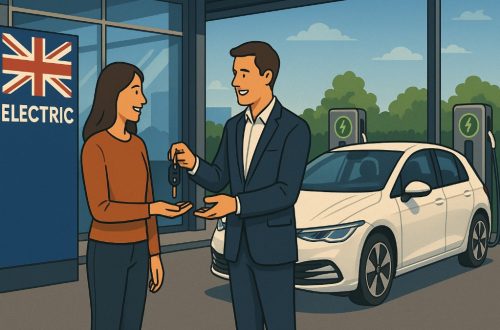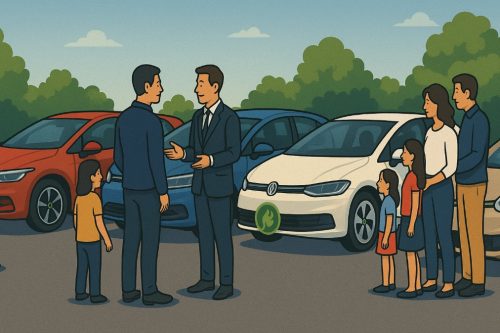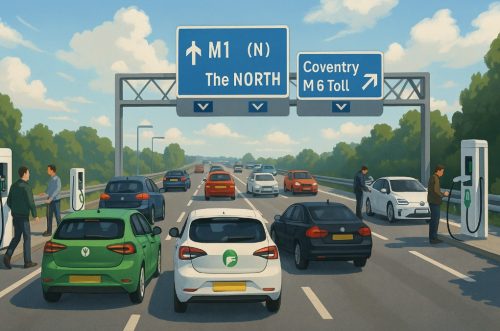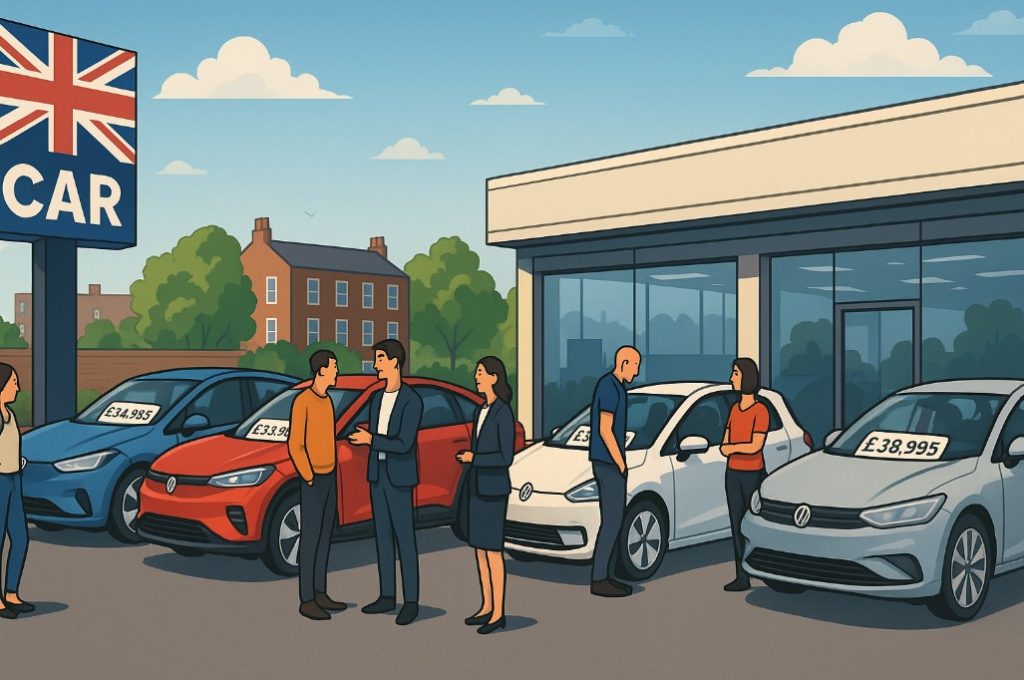Table of Contents
Are electric cars finally becoming a realistic option for the average UK driver? In a significant move to accelerate electric vehicle (EV) adoption, the UK government has introduced a revitalised Electric Car Grant (ECG) scheme.
With savings of up to £3,750 now available on 28 EV models, the initiative is designed to make EVs more accessible while fuelling economic growth and reducing emissions.
This announcement marks a major milestone in the country’s green transition, combining affordability with sustainability, and promises to reshape the future of driving across the UK.
What Is the Electric Car Grant Scheme?

The Electric Car Grant (ECG) is a UK government initiative designed to make electric vehicles more affordable and accelerate the shift away from petrol and diesel cars.
It provides an upfront discount on eligible new fully electric cars, applied directly at the dealership, so buyers don’t need to apply separately. To qualify, vehicles must meet set criteria, including price caps and sustainability standards.
The scheme tackles one of the biggest barriers to EV adoption, cost, while supporting the UK’s wider environmental targets, such as cutting carbon emissions and preparing for the 2030 ban on new petrol and diesel cars.
Backed by a £4.5 billion investment, with £650 million dedicated to affordability, it plays a key role in driving EV demand.
Why Was It Updated in 2025?
The Electric Car Grant was updated in 2025 to address key challenges facing both drivers and manufacturers in the EV transition. These changes were introduced to:
- Bridge the affordability gap between EVs and internal combustion engine vehicles
- Accelerate the UK’s transition to zero-emission transportation
- Align support with environmental performance and sustainable manufacturing
- Encourage consumer confidence by increasing eligible models
- Streamline the eligibility process with more transparent criteria
The government recognised that upfront cost remained a primary concern for many drivers. By increasing the discount to £3,750 for specific models and tightening the qualification rules, the updated scheme ensures that support reaches both consumers and manufacturers genuinely committed to clean, accessible electric transport.
How Much Can UK Drivers Save With the 2025 Electric Car Grant?
Under the revised Electric Car Grant (ECG) scheme, UK drivers can save either £3,750 or £1,500 when purchasing a new eligible electric vehicle.
The level of discount depends on the model’s environmental performance and its price, with only vehicles under £37,000 qualifying and trims capped at £42,000.
EV Grant Savings Breakdown:
| Model | Brand | Grant Amount | Base Price |
| Puma Gen-E | Ford | £3,750 | £26,245 |
| E-Tourneo Courier | Ford | £3,750 | £26,999 |
| E-308 | PEUGEOT | £1,500 | £36,800 |
| E-408 | PEUGEOT | £1,500 | £36,995 |
| DS 3 | DS | £1,500 | £35,500 |
| DS Nº4 | DS | £1,500 | £36,200 |
These discounts are applied automatically at dealerships, ensuring buyers benefit instantly without extra paperwork.
With substantial savings on popular models, the scheme is designed to make EV ownership more accessible and accelerate the UK’s move towards greener transport.
Which Electric Vehicles Qualify for the Grant and What Are the Criteria?

A total of 28 electric vehicle models are currently approved for the Electric Car Grant, either under the £3,750 or £1,500 category. To be eligible, a model must meet several key criteria, including pricing under £37,000, and production sustainability standards such as the use of renewable energy.
Additionally, the most environmentally friendly vehicles with the lowest emissions and sustainable manufacturing practices receive the higher grant. Only fully electric, zero-emission cars qualify. Hybrid or plug-in hybrid models are excluded.
The grant ensures that price reductions are applied at the point of sale, requiring no action from the consumer.
Sample of Eligible Electric Vehicles (Partial List):
| Model | Grant Value | Manufacturer |
| Citroën ë-C3 | £1,500 | Citroën |
| Cupra Born | £1,500 | Cupra |
| Nissan Ariya | £1,500 | Nissan |
| Peugeot E-2008 | £1,500 | Peugeot |
| Renault Scenic | £1,500 | Renault |
| Vauxhall Mokka Electric | £1,500 | Vauxhall |
How Were the Cars Selected for Eligibility?
The Department for Transport has introduced stricter guidelines to ensure only the most appropriate vehicles qualify for grant discounts.
Eligibility is now based not only on price but also on the environmental footprint of each model’s production process and its operating emissions.
Key factors influencing selection include:
- A retail price under £37,000
- A variant cap under £42,000
- Use of sustainable production methods
- Full battery-electric drivetrain (no hybrids)
- Compliance with emissions and safety standards
Manufacturers must submit applications for each vehicle, which are then assessed against these criteria. Only models that meet these standards are approved for listing under the grant.
What Are the Most Popular Eligible Models Right Now?
Among the 28 approved electric vehicles, a few models have garnered considerable consumer interest due to their affordability, performance, and brand recognition.
Leading the pack are the Ford Puma Gen-E and E-Tourneo Courier, both offering the full £3,750 discount. According to industry data, these models have seen up to an 80% increase in buyer interest since being added to the scheme.
Other high-demand options include:
- PEUGEOT E-208 and E-308
- DS DS3
- Citroën ë-C4
These models offer consumers not only financial savings but also a wide range of features and designs, making them suitable for families, professionals, and urban commuters alike.
How Will This £650 Million Scheme Support the UK Economy?
The UK’s new £650 million Electric Car Grant scheme goes beyond making EVs more affordable. It’s designed to strengthen the economy by creating jobs, boosting industry growth, and supporting consumer confidence.
Boosting Jobs and Industrial Strategy
The UK government’s £650 million investment is not just about cutting prices. It’s part of a broader strategy to reinforce the automotive industry, which currently supports over 133,000 direct jobs and nearly 320,000 in the wider economy.
By stimulating demand for electric vehicles, the grant is expected to spark new job opportunities in manufacturing, engineering, and EV services.
Encouraging Consumer Spending and Confidence
By putting money back into the hands of working families, the scheme is also fuelling consumer confidence.
Lower EV prices make the vehicles more accessible, encouraging more people to invest in long-term sustainable transport options while benefiting the economy.
What Role Do Carmakers Play in the Grant Process?

Car manufacturers play a central role in the ECG scheme. They are responsible for submitting their vehicle models for evaluation, ensuring that they meet the sustainability and pricing criteria required by the government. Once approved, these models are added to the list of eligible vehicles.
Leading brands like Ford, PEUGEOT, and DS Automobiles have responded positively, emphasising their commitment to clean mobility.
Ford was the first to secure the full £3,750 discount for two of its EV models, while PEUGEOT proudly announced that six of their electric models are now eligible. DS Automobiles also welcomed the grant, noting its importance in making premium EVs more accessible.
This collaboration between carmakers and the government ensures the success of the scheme and strengthens consumer trust in electric mobility.
How Is the Government Tackling Other Barriers to EV Adoption?
Aside from reducing vehicle costs, the government is addressing infrastructure and accessibility to help overcome barriers like range anxiety and charging availability.
More than 83,000 public charging points are already operational, with plans for 100,000 more through the £381 million LEVI Fund.
Additionally, the £63 million home charging package introduced in July aims to make EV ownership viable even for those without a driveway.
EV Infrastructure Initiatives
| Initiative | Description |
| LEVI Fund | £381m for expanding public EV chargers |
| Home Charging Scheme | £63m for non-driveway home installations |
| Charging Speed Improvements | Fast chargers in city centres and motorways |
| EV Charging Target | Over 100,000 public points by 2027 |
These steps ensure a smoother transition for drivers, while boosting the nation’s readiness for mass EV adoption.
Is the UK Ready for More EV Drivers on the Roads?

The UK is actively preparing for a rapid increase in electric vehicle users by investing in infrastructure and tightening regulations. With over 1.3 million EVs currently on the roads and rising consumer interest, the ecosystem is rapidly expanding.
Still, challenges remain, including:
- The need for more rural and motorway chargers
- Support for used EV buyers
- Public awareness on EV maintenance and cost benefits
These areas are receiving growing attention as the 2030 petrol and diesel ban approaches. The ECG scheme is acting as a catalyst to help address these issues, laying the groundwork for a cleaner and more accessible transport future.
How Is the Government Making EV Charging Cheaper for Homes Without Driveways?
Many households in the UK do not have off-street parking, which makes home charging a challenge. Recognising this, the government introduced a £63 million fund to support EV charging infrastructure for residents without driveways.
Key features of this initiative include:
- Installation of kerbside and lamp-post charging solutions
- Incentives for local councils to create residential charging hubs
- Grants for landlords to retrofit properties with communal charging points
Through these initiatives, the government aims to ensure:
- All EV owners can access affordable charging options
- Reduced reliance on more expensive rapid chargers
- Running costs as low as 2p per mile for efficient home setups
These efforts are not only making EV charging more inclusive but also helping to eliminate one of the most persistent barriers for city dwellers and renters.
This aspect of the grant scheme complements the vehicle discounts, making EV ownership viable for a larger section of the population.
Can This Scheme Help Close the Price Gap Between EVs and Petrol Cars?

Yes, the Electric Car Grant plays a key role in narrowing the pricing gap between EVs and petrol vehicles. The average cost of a new electric car is currently around £49,790, compared to £34,225 for petrol equivalents.
While EVs remain more expensive upfront, the £3,750 discount significantly lowers entry barriers for consumers.
In addition to the grant, many manufacturers are offering their own incentives, further shrinking the gap. When combined with lower running costs, estimated savings of up to £1,500 per year, EVs become far more competitive over time.
These financial advantages, along with increased model availability and infrastructure support, are expected to shift more buyers towards electric options in the near future.
Conclusion
The UK’s revitalised Electric Car Grant marks a critical moment in the nation’s green transport journey. With more affordable electric models, improved charging infrastructure, and manufacturer collaboration, drivers now have compelling reasons to consider making the switch.
The combination of environmental responsibility and economic incentives is transforming EV ownership from a luxury into a practical choice for many.
As the government continues to expand the scheme and support systems, the road to a fully electric future looks not only promising but also achievable for everyday drivers across the UK.
FAQs About Electric Car Grant
Do plug-in hybrid vehicles qualify for the electric car grant?
No, only fully electric, zero-emission cars are eligible under the current grant scheme. Plug-in hybrids are not included in the latest update.
How quickly can buyers access the discount at dealerships?
The grant is automatically applied at the point of sale, meaning buyers receive the discount instantly without needing to apply.
Will the £3,750 grant still apply if I choose optional add-ons?
Only if the total vehicle price including add-ons remains under the £42,000 cap. Exceeding this makes the vehicle ineligible for the grant.
Is the grant automatically applied or do buyers need to claim it?
Yes, it is automatically applied by the dealership when purchasing an eligible vehicle. No paperwork is required from the buyer.
What happens if a vehicle is just over the £42,000 cap?
Even being slightly over the cap disqualifies the vehicle. The limit is strictly enforced to ensure fairness and targeted support.
Will more models be added to the grant list soon?
Yes, the government is actively reviewing additional manufacturer applications. More eligible EVs are expected to be added in the coming weeks.
Can businesses or fleet buyers benefit from the new grant scheme?
Yes, businesses and fleet operators can use the grant for eligible EVs purchased for commercial use, subject to the same rules.




